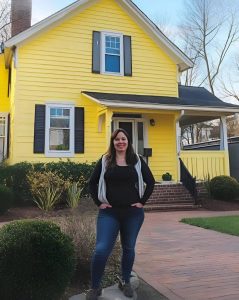When Victoria returned from a two-week work trip, she was eager to relax and settle back into the comforting routine of home. But as she turned onto her street, something immediately felt wrong. There was a strange stillness in the air, and her heart started to race. Then she saw it — and stopped dead in her tracks. Her beloved house, once a cheerful, sun-kissed yellow, had been repainted a dull and lifeless gray.

For a moment, she stood frozen, staring at the facade as her mind struggled to catch up. It wasn’t a mistake. It wasn’t a prank. Her house — her home — had been completely repainted without her permission. Rage, disbelief, and heartbreak crashed over her all at once. That yellow color wasn’t just paint to her. It had been a symbol of love, warmth, and cherished memories. Her late husband had painted it himself, calling it their “little sun.” Every time she saw it, she felt his presence. And now, that connection had been erased by people who had no right to touch it.
Victoria knew immediately who was behind it. From the day she moved into the neighborhood, her next-door neighbors — the Davises — had complained about the bright yellow color. Always dressed in muted tones and quick to share unsolicited opinions, they made it clear they didn’t approve of her house. They had tried to persuade her to repaint it several times, calling it “too loud” or “an eyesore.” But she had stood firm. It was her home, her color, and her memories.
Now, they had crossed the line.
Furious, Victoria began knocking on doors up and down the block. But suddenly, no one was home. Lights flicked off, curtains twitched, but no one opened the door. It was as if the entire neighborhood had gone silent. No one wanted to admit what they knew.
Finally, she reached Mr. Thompson’s house — an elderly man who had lived on the street for decades. He hesitated but eventually opened the door. His expression was a mixture of guilt and discomfort.
“I saw it happen,” he said softly. “They hired painters. They had papers and everything. Even the police showed up. The neighbors told them it was their property — said you authorized the repaint.”
Victoria stared at him, stunned. “But I didn’t. I was out of town.”
Mr. Thompson nodded and showed her photos on his phone. Workers with ladders, buckets of gray paint, and a printed contract — signed, stamped, and paid in cash. The contract was in the neighbors’ name, with no mention of her.
Her heart sank. This wasn’t just a misunderstanding — it was a calculated act. But she wasn’t going to let them win.
The next morning, Victoria marched into the office of the painting company. The manager’s face went pale as soon as she introduced herself.
“They told us it was their house,” he stammered. “Said they were updating the property. We had no idea—”
“You didn’t check the ownership? Not even the address?” she demanded. “You just painted over someone’s home without verifying a single thing?”
He apologized profusely, but it didn’t undo the damage.
Victoria could have sued. She had every legal right to take them to court. But something inside her wanted more than justice. She wanted to make a statement — something bold, unforgettable, and poetic. Her house was more than wood and paint. It was love. It was legacy. And no one was going to dull her light.
So she made a plan.
That night, the quiet suburban street echoed with unexpected sounds — the hiss of spray cans, the shuffle of brushes, and bursts of laughter. Victoria had hired a team of renowned local graffiti artists and given them a simple brief: Bring the sun back. But brighter.
Over the next three days, her home was transformed into a stunning tribute to joy. The yellow returned, but it wasn’t just a single shade anymore. It was layered with murals of sunflowers blooming, radiant beams of sunlight, and swirling patterns that danced across the walls. One side showed a silhouette of a man and woman holding hands under a golden sky. On the roof, in bold letters, was a message that echoed far beyond her neighborhood:
“Light beats dullness. With love, V.”
The mural became an instant sensation. Neighbors came out to take photos. The local news covered the story. Blogs and influencers reposted it. TV shows featured segments asking, “Who would cover up the sun?” Victoria’s house became a landmark — not just because of the art, but because of the message it carried. People connected with her story of loss, resilience, and bold defiance.
As for the Davises? They closed their blinds and rarely stepped outside. The once-vocal critics had suddenly gone silent. Everyone in the neighborhood knew what they’d done, and the quiet judgment from the community was louder than any confrontation.
Victoria didn’t have to say another word. Her house spoke for her — and it sang with color, courage, and love.
In the end, what had started as a petty, spiteful act turned into a radiant display of personal strength. Victoria took control of her story and reclaimed her space with a power that couldn’t be painted over.
So what do you think? Was Victoria right to respond the way she did? Have you ever had to stand up for something personal — something that truly mattered to your heart? Share your thoughts in the comments below. We’d love to hear your story.





